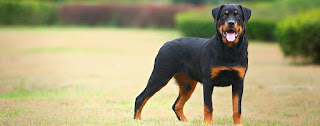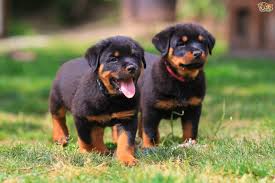Rottweilers were originally dogs bred to drive cattle to market. Later they were used to pull carts for butchers. They were among the earliest police dogs and serve with honor in the military. Most important, they are popular family guardians and friends.
Highlights
- Rottweilers are large, powerful dogs and require extensive socialization and training from early puppyhood.
- Even if you train and socialize your Rottweiler, expect to be subjected to sometimes unfair advance judgments about your dog, maybe even having untrue allegations made about him and his activities, by those who fear him.
- Because of the current prejudice against dogs such as Rottweilers and claims that they can be dangerous, you may have to carry extra liability insurance to own one, depending upon the ordinances in your town. In some areas, you may not even be able to own a Rottweiler or may be forced to give up any that you have.
- Rottweilers love people and want to be with their families. If they are left alone for long periods of time or don't receive adequate exercise, they may become destructive.
- If raised with children, well-bred Rottweilers get along fine with them. They must be taught, however, what is acceptable behavior with children. Rotties have a natural instinct to herd and may "bump" children to herd them. Because of their size, this "bump" may cause toddlers to fall down and injure themselves. In addition, some Rottweilers have a strong prey drive and may get overly excited when children run and play. Always supervise your Rottweiler when he's around children.
- If you have an adult Rottweiler, introduce new animals, especially dogs, carefully. Rottweilers can be aggressive toward strange dogs, particularly those of the same sex. Under your leadership, however, your Rottie will probably learn to coexist peacefully with his new companion.
- Rottweilers are intelligent and are highly trainable if you're firm and consistent.
- Rottweilers will test you to see if you really mean what you say. Be specific in what you ask, and don't leave any loopholes for them to exploit.
- Rottweilers require a couple of 10- to 20-minute walks or playtimes daily.
- Rottweilers have a double coat and shed heavily in the spring and the fall, moderately throughout the rest of the year.
- Many Rottweilers snore.
- If their food intake is not monitored, Rotties have a tendency to overeat and can gain weight.
- To get a healthy dog, never buy a puppy from an irresponsible breeder, puppy mill, or pet store. Look for a reputable breeder who tests her breeding dogs to make sure they're free of genetic diseases that they might pass onto the puppies, and that they have sound temperaments.
History
Rottweilers descend from the Molossus, a mastiff-type dog. Their ancestors marched to Germany with the Romans, driving the cattle that sustained them as they conquered the known world. As the army traveled, the big dogs mated with dogs that were native to the areas they passed through and laid the foundation for new breeds. One of the areas through which they passed was southern Germany, where the Romans set up colonies to take advantage of climate and soil, which were suitable for agriculture. They built villas roofed with red tile. More than 600 years later, as they were building a new church, inhabitants of the town excavated the site of the ancient Roman baths and uncovered one of the red-tiled villas. The discovery inspired a new name for the town: das Rote Wil (the red tile). Over the centuries, Rottweilers flourished as a market area for cattle, the German equivalent of a Texas cowtown, and the descendants of the Roman Molossus dogs drove the cattle to town for butchering. To keep their money safe from thieves after selling their livestock, the cattlemen put their filled purses around their Rottweiler's neck when they returned home. Butchers in the area also used the dogs to pull carts loaded with meat. Eventually, rail transport replaced cattle drives. The Rottweiler nearly became extinct. At a dog show in Heilbronn, Germany, in 1882, only one nondescript Rottweiler was exhibited. That situation began to change in 1901 when the Rottweiler and Leonberger Club was founded and the first Rottweiler breed standard was written. The description of the Rottweiler's appearance and character has changed little since then. Rottweilers began to be used in police work, for which they were well suited. Several Rottweiler breed clubs were formed over the years, but the one with staying power was the Allgemeiner Deutscher Rottweiler Klub (ADRK), founded in 1921. The ADRK survived World War II and has continued to promote good breeding programs in Germany and throughout the world. It's dedicated to preserving the working ability of the Rottweiler. It's thought that the first Rottweiler came to the U.S. with a German immigrant in the late 1920s. The first litter was whelped in 1930, and the first dog registered by the American Kennel Club was Stina v Felsenmeer in 1931. After World War II, the breed started becoming more popular. At that time, it was primarily known as an excellent obedience dog. The height of the Rottweiler's popularity was in the mid-1990s when more than 100,000 were registered with the American Kennel Club. Being popular isn't necessarily a good thing when you're a dog. It's not unusual for irresponsible breeders and puppy mills to try to cash in on the popularity of a breed and start producing puppies without regard for health and temperament problems. This is what happened to the Rottweiler breed until bad publicity and the demand for them decreased. Dedicated, reputable breeders are taking this chance to turn the breed around and ensure that Rottweilers are the type of dogs they were meant to be. Today, Rottweilers rank 17th among the 155 breeds and varieties registered by the AKC.
Size
Males typically are 24 to 27 inches tall at the shoulder and weigh 95 to 130 pounds. Females typically are 22 to 25 inches tall at the shoulder and weigh 85 to 115 pounds.



Comments
Post a Comment